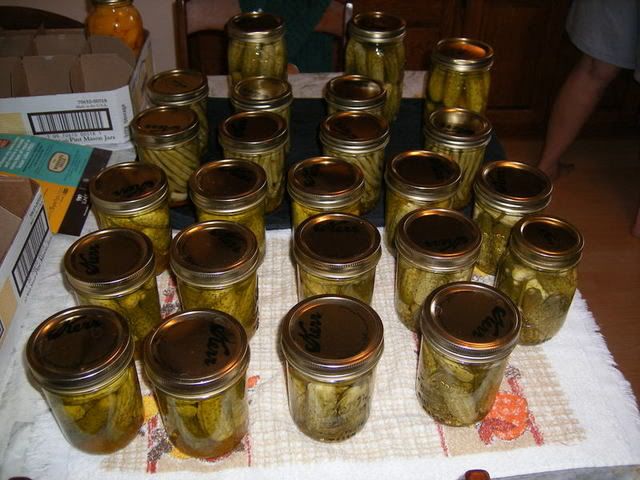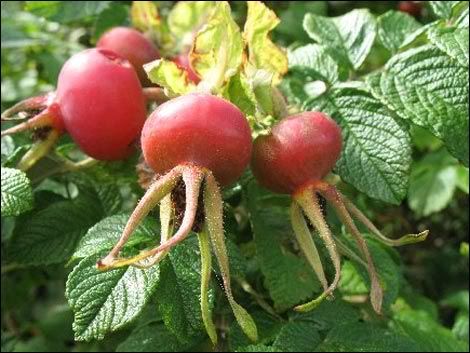
Gee, can it really be that August is already here and the harvest season is upon us? Gardeners or foragers will soon be busy picking fruits and vegetables and preserving them for the dark season. Pickled, canned and frozen fruits and veggies, oils, vinegars, jams, syrups, wine and liqueurs will see us through the winter. Though father frost still seems a long way away while we are still indulging in this harvest season's feast of plenty, soon these goodies will serve as reminders of the sweet summer days.

Foragers will delight not only in the treasures of their gardens - if they tend them, but also still find plenty of delicacies in the wilds. While Wild Strawberries (Fragaria vesca), Raspberries (Rubus idaeus) and Bilberries (Vaccinium myrtillus) tend to get scarce by now, Cranberries (Vaccinium macrocarpum) can still be found here and there. New arrivals on the berry palate are Blackberries (Rubus fruticosus) and Elder berries (Sambuccus niger), which will be ripening between now and Autumn equinox. Elder berries are very nutritious and can be preserved as a delicious syrup. The high vitamin content of this syrup is an excellent fortification against winter ailments. They also make excellent wine (for recipes see May 2002), which is even said to be good for rheumatic complaints. The Red Elderberries, (Sambucccus racemosa) are also edible after cooking and can be preserved as jams and juice. However, they lack the medicinal properties of the Black Elderberries. Raw, they are likely to cause an upset stomach. Blackberries (Rubus fruticosus) are great as jam or can be combined with tart cooking apples to make apple and blackberry crumble. Blackberries and Elderberries can also be combined as a delicious jam:

Hedgerow Jam:
1kg of berries (half and half)
1kg brown cane sugar
1 tart apple or crabapple
pectin
Clean the berries. The easiest method of picking Elderberries off their stalks is with a fork, in a kind of raking fashion. Mash the berries and mix with the sugar. Leave over night in a covered pan (glass or stoneware). Cut the apple into small pieces and simmer with a minimum amount of water until soft, add the rest of the fruits and the pectin and simmer together while stirring constantly. Adding the apple reduces the need for pectin and will produce a more solid consistency of jam. it also adds a little tangyness. Experiment with a bit of lemon peel or spices such as cinnamon, allspice berries or cloves for a more complex taste. After simmering for a few minutes fill the mass into sterilized jars as usual.
The glowing Red Rowan berries /Mountain Ash (Sorbus aucuparia) are also edible, though they are unpalatable when eaten raw. However, combined with chunks of tart cooking apples and organic lemon peel they can be processed into delicious jellies. They have also been used to make juice, wine, liqueur and various gravies, mostly served with game. However, it should be noted that large quantities of the berries have a rather stimulating effect on the digestive tract, a quality which does not diminish upon cooking. Soaking the berries overnight in a diluted vinegar solution reduces the bitterness. Rowanberry syrup is an excellent tonic for singers or public speakers as it has a great soothing effect on the vocal chords. Rowan berries are also a rich source of in vitamin C.

Rosehips (Rosa canina) are also beginning to ripen now, but it is best to hold off with the harvest. They are much better once they have been bitten by the first frost. Watch out for Hazel nuts (Corylus avellana)- the window between too early and too late is rather small, and if you are not careful squirrels and birds will beat you to the harvest.
Certain roots are coming back into season now - Ramson bulbs (Allium ursinum), Parsnip (Pastinaca sativa), Burdock and Horseradish can all be collected once their flowering season is over. However, roots should always be collected with special care. Never be greedy when collecting roots or bulbs - collecting these parts usually means the end of the plant. Unless the supply is truly plentiful in your area maybe it is wiser to refrain from harvesting the roots to ensure the continuous health and growth of the local plant population.
Leafy vegetables are definitely getting a bit old and tough by now. Still, you might be lucky and still find some young sprouts of Mallow, Daisy, Sow-thistle, Comfrey, or Bistort even this late in the season.

My favorite wild food of the season are Chantereles. Fresh from the forest, there is nothing to compare to their delicate, earthy flavor. They can be used in mushroom stir-fries, gravies or casseroles and are also delicious in omelets or lasagna. Vegetarians might appreciate them prepared as a mushroom /pine nut risotto or vegetarian paella. Also in season are Giant Puffballs, which appear in certain meadows as big, white weird looking blobs. Upon closer investigation the mass turns out to be an edible delicacy, frequently big enough to feed a whole family. Sliced and marinated with garlic-oil they can be fried or grilled like steaks. Delicious!
Hedegrow Jam sounds nummy DancingFire! :)
ReplyDeleteMUAH!!!
Sorry I wasn't in last evening...the grandbabes and Momma stopped in for a while...I know, right?
That's two Friday nights now...we all had watermelon together and watched Wife Swap! Too funny! Anywho, that is why I didn't get on blogger like I said I was going to! Watching Little Grandmother twirl in her pink tutu and Firekeeper do sit ups, lol!
Have a good weekend love...it is going to be a humid next week or so here...the plants should love it!
Loving You Immensely and Then Some!
xoxo
Nice post! Thai Hung Company is committed to providing consumers and consumers with quality, safety and health products for consumers:
ReplyDeletecách dùng trà giảo cổ lam
mua trà giảo cổ lam ở hà nội
trà cà gai leo có tác dụng gì
Please come with us.